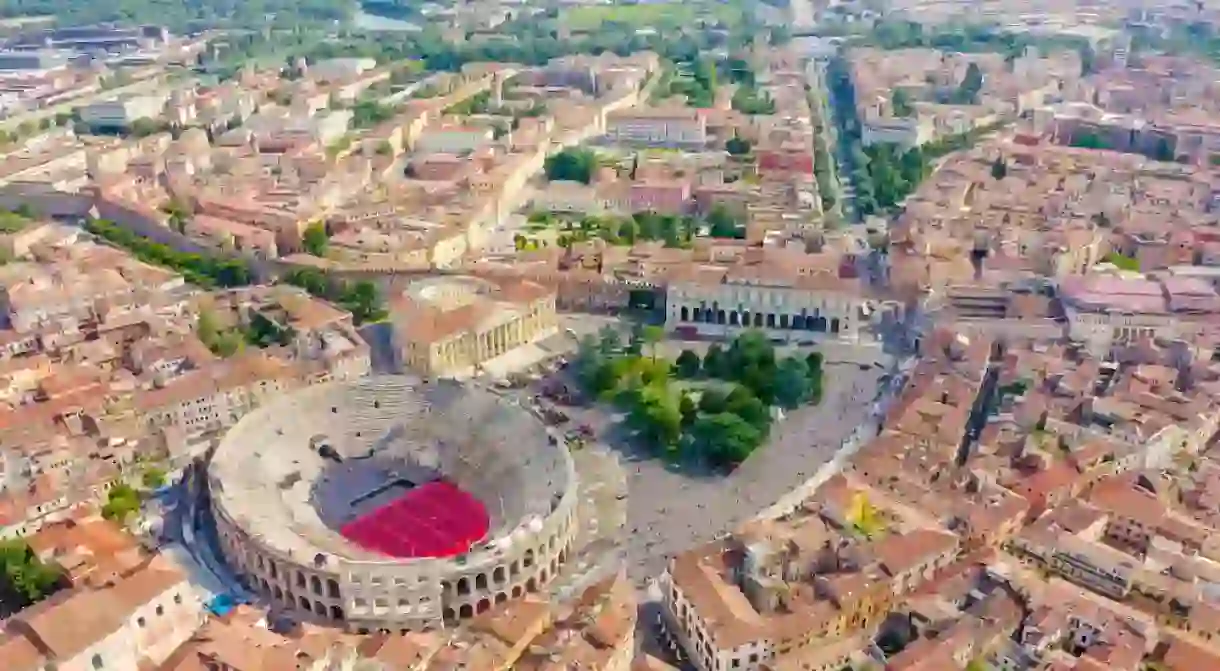Everything You Need to Know About Verona Arena, Italy

Built in the first century, the Verona Arena is an open-air Roman amphitheater that’s still fully in use today, making it one of the best-preserved ancient structures in the world. That means that these stones have seen everything from gladiator games to One Direction concerts, from medieval jousts to Puccini operas. Its colorful palimpsest of histories makes it a perfect representation of Verona itself.
A Brief History
The city was built up in the first stage of the Roman Empire’s expansion because of its strategic location on the river Adige. It was used as a base for controlling the northern territories, and it was at the center of many important roads. You can see the footprints of this ancient history all around the city, as Roman ruins are incorporated with nonchalance into the everyday fabric of the infrastructure. The Arena today is located in the historic center of the city, but back in Roman times it was on the border of the urban area, just outside the city’s walls.

Is Verona Arena older than Rome’s Colosseum?
The Colosseum of Rome may be Italy’s most iconic amphitheater, but it isn’t the oldest. Verona Arena was built almost 2,000 years ago, back in 30 AD, some 40 years before gladiators entered the Colosseum. While not as famous or large, Verona Arena remains one of the finest Roman remains in Europe, and still stands as the third largest surviving amphitheater on the continent.
How many people did it hold?
The Arena, made from pink and white stone from nearby Valpolicella, originally had three tiers of arches running along the border, although only two survived. The place held 20,000-30,000 people in its heyday, hosting festivals that would draw visitors from all over. It was a complex and demanding entertainment industry, powered by the labor of hundreds of slaves in the underground tunnels. Grandiose stage sets would be erected in the central space. The elliptical shape gives the space excellent acoustics.

What kind of events were held there?
There were processions, circus acts, dancing and music, but, above all, the citizens came to see blood sports. Fierce wild animals from faraway places in the empire were brought in to be hunted, and condemned prisoners were executed in bloody and inventive ways. The feature presentation was always a gladiator show, in which two trained combatants would fight one another to the death. The word “arena” means sand, and it refers to the sand that covered the floor of the ring to absorb the blood spilled during the fights.
In the 16th and 17th centuries, the theater hosted games and tournaments. The first documented joust took place here in 1590, with all kinds of equestrian games plus knights demonstrating their horsemanship and fighting skill.
Both Veronese knights and foreigners came to participate, from even as far as Sweden. Shows like bull hunting continued into the 17th century, and exotic animal exhibits were always popular. In 1751, a rhino was shown in the Arena to the wonder of all the spectators.
Is the Arena still in use today?
The Arena continues to play host to a variety of important cultural events. It’s one of the best places in the world to see opera, at the yearly summer festival, which hosts up to four different productions and is extremely popular among locals and culture vultures across Northern Italy. Opera was first performed here during the Renaissance, but became a regular venue throughout the 20th century. Today opera season lasts from June to August, welcoming around half a million audience members each year. Unlike its Roman heyday, the venue now safely holds around 15,000, with some padded seats in the central area, as well as the cheaper (and more authentic!) original seating.

Plenty of contemporary music has echoed from this ancient structure, too, with a whole host of huge concerts held here over the year. Icons like Bruce Springsteen, Björk and Paul McCartney have played here, as well as bands like Pearl Jam, Radiohead and Italian glam rockers Måneskin, of Eurovision fame. It was even the setting for 2011 Bollywood movie Rockstar.
As one of the region’s most iconic landmarks, Verona Arena tends to be used in a range of other capacities, too. The podium of the Giro d’Italia, one of the world’s most prestigious cycling races, has been held here on multiple occasions, while the closing ceremony for the Winter Olympics will also be hosted here in 2026.
How to visit Verona Arena
Architectural Landmark, Historical Landmark

The Arena is open every Tuesday-Sunday, with closures every Monday and on Christmas and New Year’s Day. You can visit from 9am until 7pm, although last entry is at 6.30pm. Opening times do change fairly regularly throughout the year, sometimes in order for restoration work to be completed, but most commonly when events are being held. Expect reduced opening hours during opera season, for example.
Buying a ticket ahead of your visit is highly recommended, and you should always arrive 15 minutes before your scheduled ticket. Entry is free for accompanied children, while adults pay around €17 (£14).
Skip-the-line tickets with an accompanied guide can also be bought for £25, while pretty much every single walking tour of Verona will include a visit to the Arena. Some of these tours include your admission fee, but some don’t, so always be sure to check before booking!
Trips and Tours in Italy
Architectural Landmark

Planning your holidays in Italy? Check out our diverse collection of multi-day tours all over the country, featuring grand old cities like Verona, Venice and Florence, as well as dreamy coastlines in Puglia, Calabria and the Amalfi Coast, not to mention the luscious foodie trails of Tuscany and Emilia Romagna.













